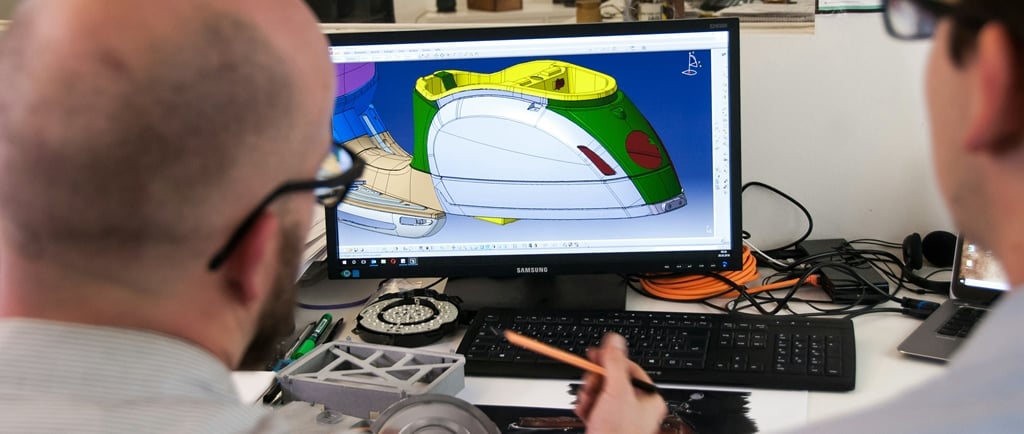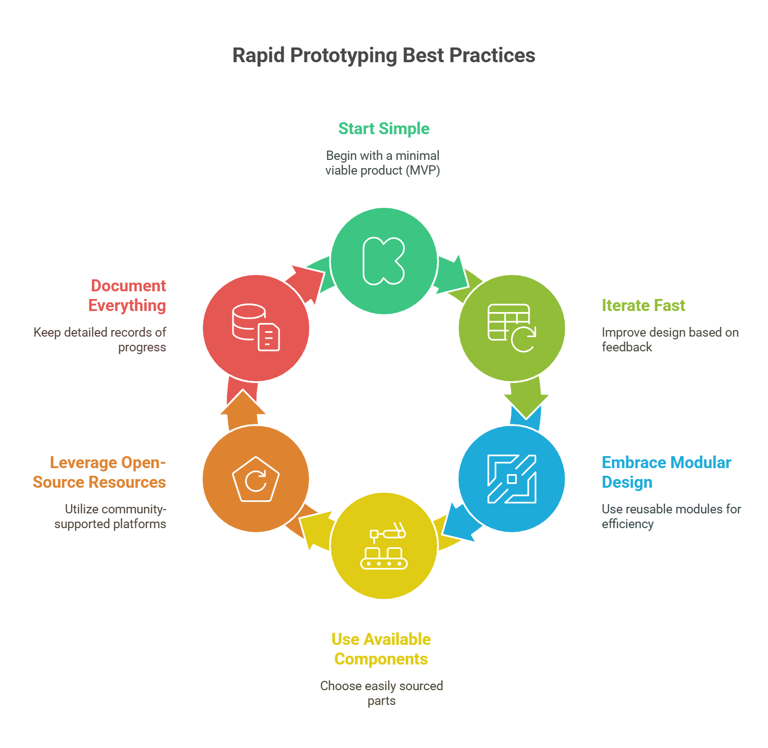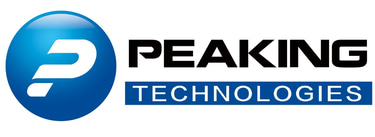Prototyping 101: Best Practices for Rapid Electronics Development
Bringing a new electronics product to life is an exciting yet challenging journey. Whether you're designing a smart home device, an IoT gadget, or an industrial sensor, rapid prototyping plays a crucial role in reducing development time and ensuring a smooth path to production.
2/15/20254 min read


Bringing a new electronics product to life is an exciting yet challenging journey. Whether you're designing a smart home device, an IoT gadget, or an industrial sensor, rapid prototyping plays a crucial role in reducing development time and ensuring a smooth path to production. However, many designers and project managers find themselves facing bottlenecks—long lead times, unexpected design flaws, and costly iterations.
This guide is designed for those who make key decisions in electronics product development—designers, engineers, and project leads. We’ll cover essential best practices to help you navigate rapid prototyping efficiently while avoiding common pitfalls.
1. Understanding the Prototyping Process
What Is a Prototype?
A prototype is an early version of a product used to test its functionality, design, and feasibility before full-scale production. In electronics development, a prototype can be as simple as a breadboard circuit or as refined as a near-final production unit.
Different Stages of Prototyping
Electronics prototyping is an iterative process that evolves through different stages:
Proof of Concept (PoC): Demonstrates core functionality with minimal design complexity.
Functional Prototype: Incorporates essential features and allows for testing hardware and firmware integration.
Pre-Production Prototype: A refined version with manufacturability considerations, ready for small-batch testing.
Understanding these stages ensures that resources are allocated efficiently and that teams focus on iterative improvements rather than perfection at an early stage.
2. Choosing the Right Prototyping Method
Selecting the right prototyping method is crucial to keeping development agile. Here are some of the most effective methods used in electronics design:
Breadboarding: Great for quick validation of circuit concepts but not suitable for long-term use.
Custom PCB Prototyping: Moves beyond breadboarding to improve reliability and performance.
3D Printing & CNC Machining: Ideal for housing and mechanical enclosures.
Simulation & Virtual Prototyping: Tools like LTspice, Altium Designer, and KiCad can help simulate circuits before physical testing.
By selecting the right approach for each phase, teams can reduce wasted effort and costs.


3. Essential Best Practices for Rapid Prototyping
To ensure a smooth prototyping process, follow these best practices:
Start Simple & Iterate Fast
Resist the temptation to create a fully polished design in the first prototype. Start with a minimal viable product (MVP) and improve based on testing feedback.
Embrace Modular Design
Breaking your design into smaller, reusable modules can help with faster debugging and repurposing. This is particularly useful for IoT and embedded systems projects.
Use Readily Available Components
Opt for widely available components rather than hard-to-source or custom parts. This reduces procurement delays and simplifies future manufacturing.
Leverage Open-Source Hardware & Libraries
Open-source platforms like Arduino, Raspberry Pi, and ESP32 can save time by providing tested libraries and robust community support.
Document Everything
Many teams neglect documentation in the rush to prototype. Keep track of circuit schematics, firmware versions, and test results. Future you—and your manufacturing partners—will thank you.
4. Tools & Technologies for Faster Prototyping
Having the right tools can drastically speed up development. Here are some essentials:
EDA (Electronic Design Automation) Software
KiCad: Open-source PCB design tool for professionals.
Altium Designer: A high-end tool for complex board layouts.
Eagle: A popular choice for small and medium-sized projects.
Microcontrollers & Development Boards
Arduino: Perfect for fast prototyping and community support.
Raspberry Pi: For more computationally intensive applications.
ESP32: A go-to choice for WiFi and Bluetooth-enabled devices.
PCB Prototyping Services
Prototyping printed circuit boards (PCBs) efficiently is essential for validating designs before mass production. Several services specialize in quick-turn PCB fabrication with options tailored to different needs:
JLCPCB: Offers budget-friendly prototyping with fast turnaround times, making it ideal for startups and hobbyists.
PCBWay: Provides a balance between cost and customization, with options for multilayer boards and assembly services.
OSH Park: Focuses on high-quality PCB fabrication with a community-driven approach, popular among open-source developers.
Seeed Studio Fusion: An excellent choice for small-batch orders, offering design review assistance and integration with other prototyping services.
Advanced Circuits: Specializes in high-reliability PCB prototypes, catering to industries with stringent performance requirements such as aerospace and medical electronics.
Choosing the right PCB prototyping service depends on factors such as lead time, cost, material options, and additional services like component sourcing and assembly. Partnering with a service that aligns with your project’s needs can significantly reduce development cycles.
Testing & Debugging Tools
Oscilloscopes & Logic Analyzers: Essential for debugging timing issues.
Multimeters: The simplest but most critical tool for electrical testing.
By integrating these tools into your workflow, you can reduce development bottlenecks and improve the overall efficiency of your design process.
5. Common Pitfalls and How to Avoid Them
Even experienced teams can fall into these common traps. Here’s how to avoid them:
Ignoring Manufacturability & Scalability
Many prototypes work well in the lab but fail in production due to poor design for manufacturing (DFM). Collaborate with manufacturers early to ensure your design is scalable.
Poor Component Selection
A component might be perfect in terms of functionality but unavailable or too expensive for mass production. Always check supply chain constraints before finalizing designs.
Skipping Proper Testing
Testing should go beyond functional validation. Consider:
Thermal testing: Ensuring your product won’t overheat.
EMI/EMC testing: Avoiding electromagnetic interference issues.
Real-world stress tests: Assessing performance in actual operating conditions.
Underestimating Costs & Lead Times
It’s easy to overlook small expenses in early-stage prototyping, but costs can escalate quickly. Factor in production, shipping, and assembly times to avoid surprises.
6. When to Move from Prototype to Production
So, how do you know when your prototype is ready for manufacturing? Here are some key indicators:
Stable Hardware & Firmware: Core functions work consistently with no major bugs.
Verified Manufacturability: Your design meets DFM and DFA (Design for Assembly) guidelines.
Validated Performance: Field tests confirm reliability and user expectations.
Cost Analysis Completed: Material and production costs align with business targets.
At this stage, transitioning to small-batch production for final validation ensures a smooth scale-up process.
Choosing a Manufacturing Partner
Selecting the right manufacturing partner during prototyping is crucial for a seamless transition to production. Look for a partner with experience in your industry, a track record of working with startups or product developers, and the ability to provide small-batch runs. Evaluate their communication, turnaround times, and willingness to offer design feedback. A good manufacturer not only produces prototypes but also helps refine designs for efficiency, cost-effectiveness, and scalability.
Conclusion
Rapid prototyping is the backbone of successful electronics development. By following best practices—starting simple, embracing modularity, selecting the right tools, and avoiding common pitfalls—you can significantly reduce development time and costs.
As a designer or project decision-maker, your role is to balance speed with precision. The right approach to prototyping will not only lead to a better product but also a smoother path to mass production.
